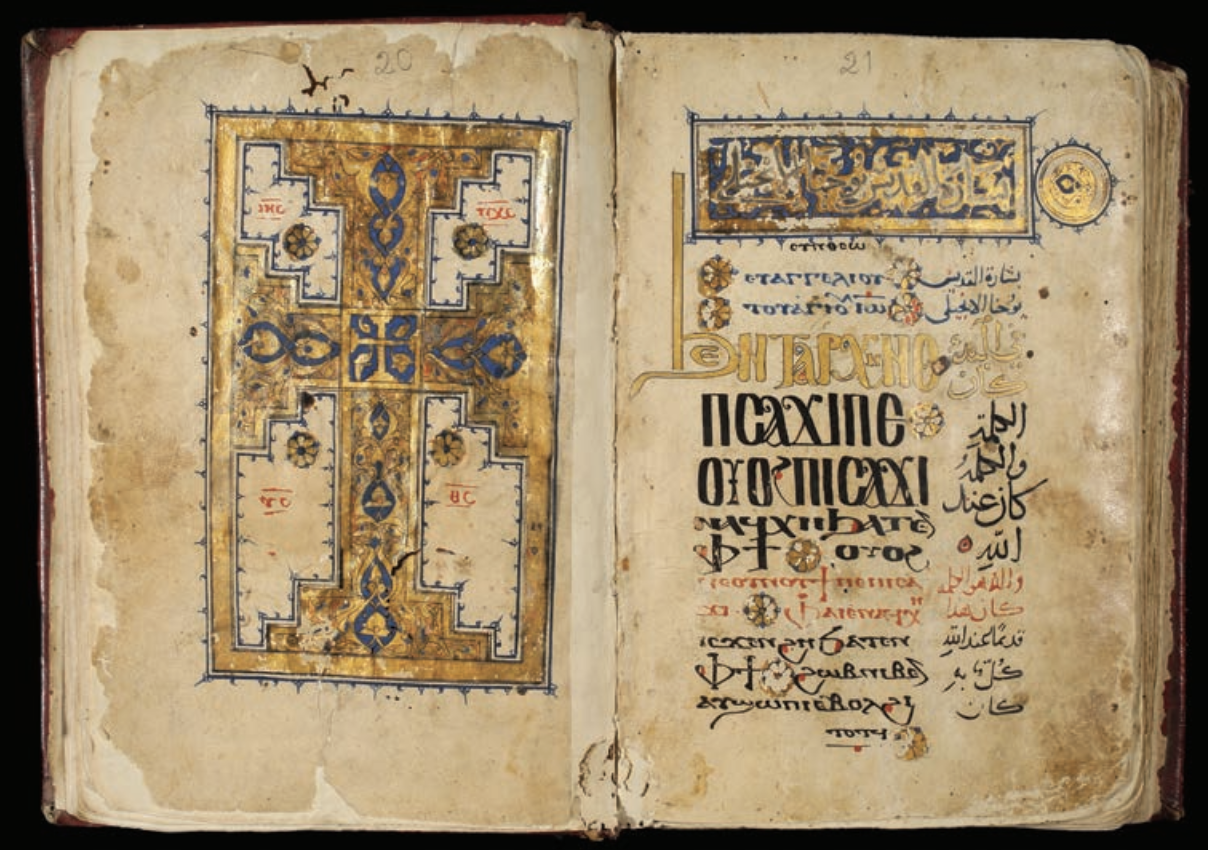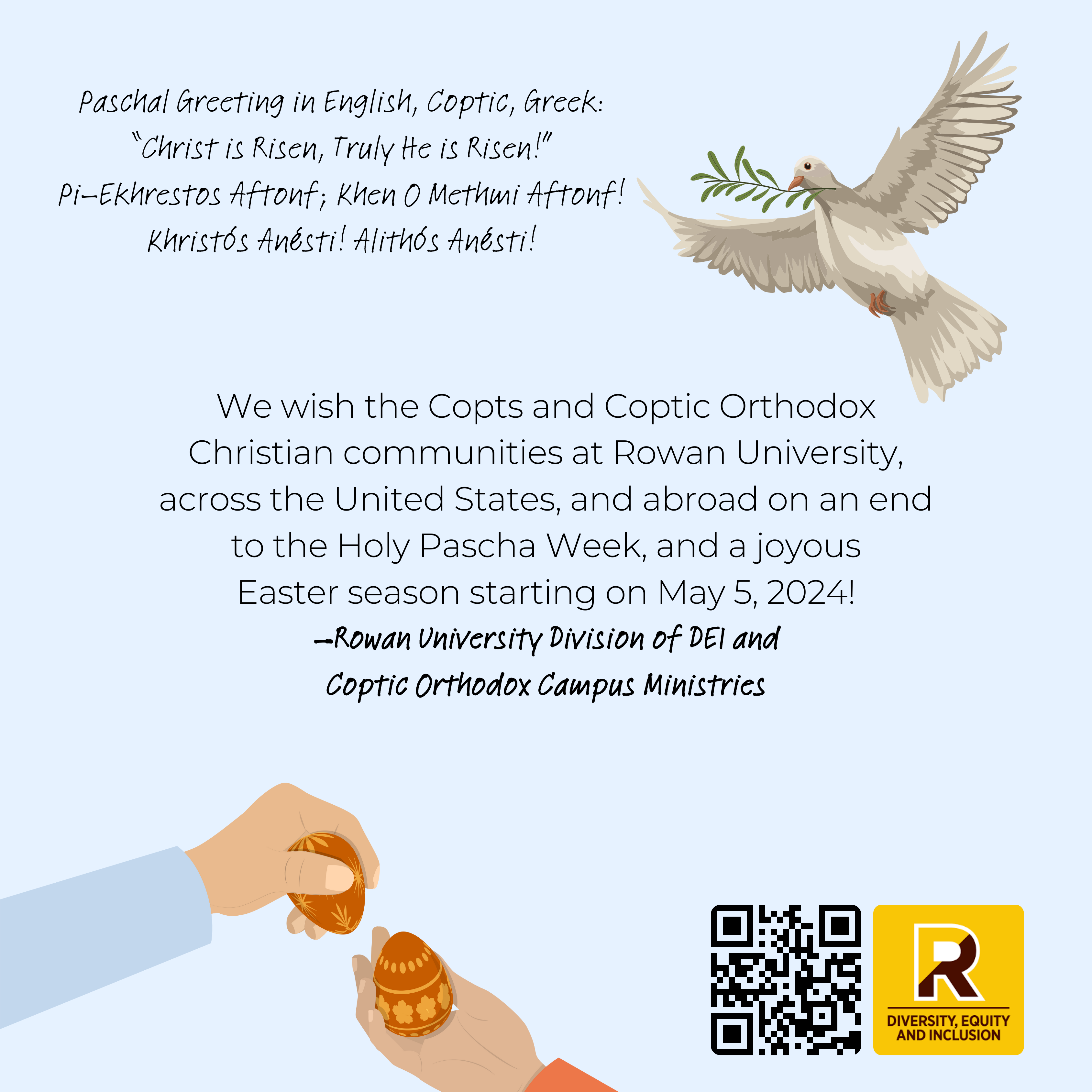Image Alternative Text: Depicted is a white dove with a green olive branch, and hands holding paschal eggs in shades of red–orange and gold. The background of the image is light blue.
The text at the top of the graphic reads, "Paschal Greeting in English, Coptic, Greek: 'Christ is Risen, Truly He is Risen'; Pi–Ekhrestos Aftonf; Khen O Methmi Aftonf!; and Khristós Anésti! Alithós Anésti!. We wish the Copts and Coptic Orthodox Christian communities at Rowan University, across the United States, and abroad on an end to the Holy Pascha Week, and a joyous Easter season starting on May 5, 2024! —Rowan University Division of DEI and Coptic Orthodox Campus Ministries."
The Rowan University Division of Diversity Equity, and Inclusion (DEI) logo is depicted in the bottom right corner.
Click here to download the graphic.
This article was written for the Rowan University community at large by Dimitry S. Faltas, Undergraduate Student and President of the Rowan University Coptic Orthodox Campus Ministries; and Patricia Fortunato, for the Rowan University Division of Diversity, Equity, and Inclusion (DEI). Please contact Fortunato at fortun83@rowan.edu with comments and/or inquiries in regard to research and contents.
Contents are developed and produced with gratitude to families/loved ones, students, academic faculty, and staff. The Division of DEI and Coptic Orthodox Campus Ministries strive to support all Rowan University communities who identify as Coptic Orthodox Christian, Coptic Catholic, and/or other communities who observe and/or support those who observe, during this special time of spiritual beauty, depth, rebirth, and renewal.
Follow the Rowan University Division of DEI:
- Instagram: instagram.com/rowandei
- Facebook: facebook.com/rowandei
- X/Twitter: twitter.com/rowandei
- Threads: threads.net/@rowandei
Holy Pascha Week and Coptic Orthodox Easter
On the evening of May 4, 2024, at the end of the Holy Pascha Week, Coptic Orthodox Christian communities celebrate the resurrection of Christ. It is considered the most significant day in the Orthodox Christian faith.
Prior to this observance, Coptic Orthodox Christian communities tend to fast for 55 days. The last week of fasting is considered Holy Pascha Week, and indicates a most sacred time of year among communities. Those exempted from fasting as part of the Coptic Orthodox Christian Church include children, pregnant people, people who are nursing, older adults/geriatric population, and those with medical complications. It is during this time that Orthodox Christian communities hold belief that a light emerges from Christ's tomb in Jerusalem—the same light that emerged when Christ rose from the dead.
On this special evening, Pope Tawadros II of Alexandria celebrates the Holy Resurrection Feast in Saint Mark's Coptic Orthodox Cathedral in Azbakeya, Cairo, Egypt. The liturgy is celebrated with a reenactment of Christ rising from the dead.
Coptic Orthodox Christian Church
The Coptic Orthodox Christian Church is a traditional church dating back to the time of Saint Mark and the Twelve Apostles, as relayed in Christian theology and ecclesiology, who were the primary disciples of Christ according to the New Testament. The Church uses an apostolic succession from Saint Mark to Pope Tawadros II, and was established in approximately 50 AD by Saint Mark.
We wish the Copts and Coptic Orthodox Christian communities at Rowan University, across the United States, and abroad on a successful end to the Holy Pascha Week, and a joyous Easter season starting on May 5, 2024!
Paschal Greeting in the English, Coptic, and Greek languages:
"Christ is Risen, Truly He is Risen!"
Pi–Ekhrestos Aftonf; Khen O Methmi Aftonf!
Khristós Anésti! Alithós Anésti!
*The Twelve Apostles, as relayed in Christian theology and ecclesiology and according to the New Testament, comprised the following:
- Simon, also known as Peter
- Andrew, Peter's brother
- Jacob/James (son of Zebedee and John's brother)
- John (son of Zebedee and Jacob's brother)
- Philip (friend of Bartholomew/Nathanael)
- Bartholomew (friend of Philip; the Gospel of John references him as Nathanael)
- Matthew (the publican, or Levi)
- Thomas (also referenced as Didymus, this is the translation of his Hebrew name in the Greek language)
- Jacob/James (son of Alphaeus to distinguish him from Jacob/James)
- Simon (the Canaanite)
- Judas Iscariot (son of Simon Iscariot; Iscariot is used to distinguish him from Jude, Judas of Jacob)
- Jude (Thaddaeus, or Lebbaeus; he was referenced as "Judas the Zealot" in some translations)
*An Eastern Christian tradition teaches that there were Seventy Apostles, early messengers of Christ per the Gospel of Luke. Learn more about this recognition via the Orthodox Church in America (OCA).1
Christianity in the Middle East and North Africa
Copts are a Christian ethnoreligious group, indigenous to North Africa, who primarily reside in Egypt. They remain the largest Christian denomination in Egypt;2 in addition to Libya, North Africa;3 and Sudan, Northeast Africa.4
The Coptic language is the most recent, or modern, stage of the Egyptian language. It was the spoken language of majority Egyptians until replaced by the Egyptian Arabic language at the end of the 17th century.5 In present-day, the language is dormant; however, it remains the sacred language of the Coptic Orthodox Church and Coptic Catholic Church.
Christians in the Middle East and North Africa (MENA) are indigenous to these geographical areas and include Oriental Orthodox Churches, Eastern Orthodox Churches, the Assyrian Church of the East, Catholic Churches, and Protestant communities. It is important to note that while two-thirds of adults in the United States identify as Christians, according to the Pew Research Center,6 those who identify as Christians in the MENA comprise 5% of the total population, decreased from 13% in the 20th century.7
Learn more about religious freedom, as well as the Coptic language, among the following resources for continued learning.

Image Alternative Text: Depicted is a 14th century manuscript, featuring script in the Coptic and Arabic languages, from the Monastery of Saint Macarius the Great, a Coptic Orthodox monastery in Wadi El Natrun, Beheira Governorate, Egypt. The manuscript depicts the introduction of the Gospel of John.8
The image is via the Hill Museum and Manuscript Library (HMML), a global organization that prioritizes digital preservation of manuscripts sourced from vulnerable geographical regions.
Resources for Continued Learning
Reports:
- United States Commission on International Religious Freedom (USCIRF). (2024). 2024 Annual Report of the U.S. Commission on International Religious Freedom. USCIRF. Retrieved from uscirf.gov/news-room/releases-statements/uscirf-releases-2024-annual-report-new-recommendations-us-policy on May 3, 2024.
- United States Department of State. (2023). Annual Report to Congress on International Religious Freedom. Office of International Religious Freedom, U.S. Department of State. Retrieved from state.gov/reports/2022-report-on-international-religious-freedom on May 3, 2024.
Articles:
- Ferree Womack, D. (2022). Christians in and from the Middle East: Lessons from the World Christian Encyclopedia. International Bulletin of Mission Research, 46(1), 15–24.
- Marteijn, E. S., & Schouten, L. (2022). Heritage and Identity. Exploring the Middle East within World Christianity. Studies in World Christianity, 28(3), 255–266.
- Wilson, L. (2022). Preserving the Coptic Language. New Lines Magazine. Retrieved from newlinesmag.com/essays/preserving-the-coptic-language on May 3, 2024.
- Stern, A. (2019). Coptic Language Manuscripts. Humanities: The Magazine of the National Endowment for the Humanities. Retrieved from neh.gov/article/coptic-language-manuscripts on May 3, 2024.
Educational Websites:
Hill Museum and Manuscript Library (HMML): This global organization is dedicated to "preserving and sharing the world's handwritten past to inspire a deeper understanding of our present and future." Digitized manuscript collections include the following:
- Eastern Christian contents, from Africa, the Middle East, and South Asia, with holdings in Armenian, Coptic, Church Slavonic, Geʽez, and Syriac languages;
- Islamic contents, from Africa, the Middle East, and Asia, in Arabic, Persian, Turkish, and Urdu languages;
- Buddhist and Hindu contents, from Nepal and Laos in Hindi, Lao, Malay, Malayalam, Nepali, Newari, Pali, and Sanskrit languages;
- contents from Malta and the Most Venerable Order of the Hospital of Saint John of Jerusalem, from throughout the Mediterranean region;
- and contents from Western Europe, in Latin and vernacular languages. Learn more at hmml.org.
References
- Orthodox Church in America (OCA). (2024). Synaxis of the Seventy Apostles. OCA. Retrieved from oca.org/saints/lives/2024/01/04/100017-synaxis-of-the-seventy-apostles on May 3, 2024.
- Rehbein, M. Who are Egypt's Coptic Christians?. (2017). Cable News Network (CNN) World. Retrieved from edition.cnn.com/2017/04/09/middleeast/egypt-coptic-christians/index.html on May 3, 2024.
- United States Department of State. (2023). 2022 Report on International Religious Freedom: Libya. Office of International Religious Freedom, U.S. Department of State. Retrieved from state.gov/reports/2022-report-on-international-religious-freedom/libya on May 3, 2024.
- United States Department of State. (2023). 2022 Report on International Religious Freedom: Sudan. Office of International Religious Freedom, U.S. Department of State. Retrieved from state.gov/reports/2022-report-on-international-religious-freedom/sudan on May 3, 2024.
- Allen, J. P. (2020). Coptic: A Grammar of Its Six Major Dialects. Penn State Press.
- Pew Research Center. (2022). Modeling the Future of Religion in America. Pew Research Center. Retrieved from pewresearch.org/religion/2022/09/13/modeling-the-future-of-religion-in-america on May 3, 2024.
- Ferree Womack, D. (2022). Christians in and from the Middle East: Lessons from the World Christian Encyclopedia. International Bulletin of Mission Research, 46(1), 15–24.
- Hill Museum and Manuscript Library (HMML). (2017). Illuminations. HMML. Retrieved from hmml.org/assets/pdf/Illuminations-Fall2017.pdf on May 3, 2024.
